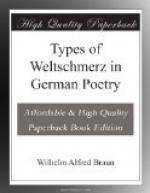less bitterly her husband’s violent interference.
But returning to the poem “Hyperion,” for
as such we may regard it, we find in it the most complete
expression of the attitude which the poet, in his
Weltschmerz, assumed toward nature. Nature is
his constant companion, mother, comforter in sorrow,
in his brighter moments his deity. This nature-worship,
which speedily develops into a more or less consistent
pantheism, Hoelderlin expresses in Hyperion’s
second letter, in the following creed: “Eines
zu sein mit allem, was lebt, in seliger Selbstvergessenheit
wiederzukehren ins All der Natur, das ist der Gipfel
der Gedanken und Freuden, das ist die heilige Bergeshoehe,
der Ort der ewigen Ruhe."[69] And so nature is to
Hoelderlin always intensely real and personal.
The sea is youthful, full of exuberant joy; the mountain-tops
are hopeful and serene; with shouts of joy the stream
hurls itself like a giant down into the forests.
Here and there his personification of nature becomes
even more striking: “O das Morgenlicht
und ich, wir gingen uns entgegen, wie versoehnte Freunde."[70]
Still more intense is this feeling of personal intimacy,
when he exclaims: “O selige Natur! ich
weiss nicht, wie mir geschiehet, wenn ich mein Auge
erhebe von deiner Schoene, aber alle Lust des Himmels
ist in den Thraenen, die ich weine vor dir, der Geliebte
vor der Geliebten."[71] It is important for purposes
of comparison, to note that notwithstanding his intense
Weltschmerz, in his treatment of nature Hoelderlin
does not select only its gloomy or terrible aspects.
Light and shade alternate in his descriptions, and
only here and there is the background entirely unrelieved.
The thunderstorm is to him a dispenser of divine energies
among forest and field, even the seasons of decline
and decay are not left without sunshine: “auf
der stummen entblaetterten Landschaft, wo der Himmel
schoener als je, mit Wolken und Sonnenschein um die
herbstlich schlafenden Baeume spielte."[72] One passage
in “Hyperion” bears so striking a resemblance,
however, to Lenau’s characteristic nature-pictures,
that it shall be given in full—although
even here, when the gloom of his sorrow and disappointment
was steadily deepening, he does not fail to derive
comfort from the warm sunshine, a thought for which
we should probably look in vain, had Lenau painted
the picture: “Ich sass mit Alabanda auf
einem Huegel der Gegend, in lieblich waermender Sonn’,
und um uns spielte der Wind mit abgefallenem Laube.
Das Land war stumm; nur hie und da ertoente im Wald
ein stuerzender Baum, vom Landmann gefaellt, und neben
uns murmelte der vergaengliche Regenbach hinab ins
ruhige Meer."[73]




